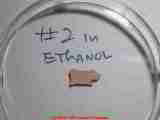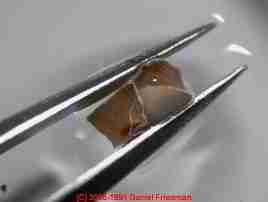 Paint Sample Chemical Analysis Procedures: Oil vs Alkyd paint
Paint Sample Chemical Analysis Procedures: Oil vs Alkyd paint
- POST a QUESTION or COMMENT about paint testing methods, Ethanol test, KOH test, & forensic microscopy and microchemistry for paint type identification - an aid in paint failure analysis
Paint sample or chip tests for paint type identification:
An Oil paint or alkyd paint vs. latex or acrylic paint identification procedure is explained here. This article describes a simple procedure for preparing paint samples for reflected light low to high magnification microscopic examination in the paint failure laboratory. A procedure is described for mounting sectioned paint chips on edge for microscopic examination.
This procedure is useful in the determination of paint layers, paint layer thickness measurement, and paint layer interactions. The procedure also permits detection of mold or debris which has been painted over.
Two simple chemical tests are described for identification of paint as acrylic or alkyd, useful as a quick, inexpensive alternative to pyrolysis gas chromatography,.
We include photographs of the procedure for preparing paint chips for cross-section and flat surface analysis. and photos of the results of simple chemical analysis to identify paint samples as acrylic or alkyd paints.
InspectAPedia tolerates no conflicts of interest. We have no relationship with advertisers, products, or services discussed at this website.
- Daniel Friedman, Publisher/Editor/Author - See WHO ARE WE?
Simple Chemical Tests Can Often Identify Acrylic and Alkyd Paints
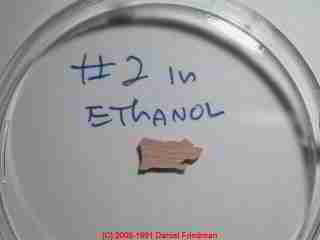
The diagnosis and cure of paint failure on buildings, particularly on wood siding and trim, is quite possible if there is a careful and thorough inspection of the building, its history, its surfaces, and the actual points of paint failure.
It is diagnostic to compare the same coating on the same type of surface at different locations on a building and in areas of failed and not-failed paint.
[Click to enlarge any image]
The identification of a paint chip sample as acrylic or alkyd-based is important for art conservationists, but also for more prosaic paint failure investigators who examine buildings.
During investigation of peeling and flaking paint on a costly historic restoration project of an 18th century building we suspected that a contractor had been supplied incompatible paints or that not all of the primer used on the building was the same material, and that the primer was not intended for exterior use. The paint sample above is from that project.
By identifying the type of paint used we made a definite and easy determination that the paint applied was not the paint for which the park service had contracted.
With as stance from two experts, one an experienced paint chemist and the other, an expert art conservator, we here document the procedure for two very simple chemical tests that can often (not always) distinguish between oil/alkyd paints and latex-based paints.
Paint testing laboratories use either chemical methods and/or infra-red spectrometry to identify binders used in paints. Infrared spectroscopy is the most fundamental way to identify almost any organic material.
Pyrolysis GC/MSD is a useful back up method, and has been used in the art conservation field. See Analysis of Modern Paints at References below.
All organic materials have a unique infrared spectrum or 'finger print'. Some paint testing labs (Bodycote) inform us that the following combination of paint testing methods are the most precise in paint identification and can be used to reverse-engineer a paint from a paint sample.
- Fourier transform infrared spectroscopy (FTIR) to determine the type of resin in the paint
- Thermogravimetric analysis (TA) to determine the fillers present in the paint
- Scanning electron microscopy (SEM) coupled with energy-dispersive X-ray spectroscopy to determine the elemental composition of the paint chip.
These tests are costly, ranging from $450. to $1000. per test per sample. In contrast, the chemical tests we describe here should cost less than ten percent of those higher fees. However the tests need to be performed by an experienced forensic investigator or microscopist trained in microchemistry.
A Description of Two Simple Chemical Tests to Examine Paint Chips
Chemical tests to examine paint chips or painted surfaces, while less precise and less informative, are very quick, inexpensive, and can be used in the field as well as in the laboratory. Therefore chemicals are mainly used on site and infra-red is used in the lab.
The most common chemical methods for examining paint in the field or for a "quick lab test" are:
- NaOH-solution will make alkyd and oil paint surfaces turn yellow, but will not affect acrylates. (4% NaOH, but KOH can also be used. KOH was used for the tests shown in photographs in the first paint test series in this document while ethanol was used in the second test series performed by Fred Colley.)
- Ethanol will soften acrylates but will not affect alkyd and oil paints.
Mixed-base paints lead to ambiguous results: This chemical method for paint testing will not always give a definitive answer. For example if a water-based paint is comprised of both alkyd and acrylate components the chemical test will be ambiguous.
However these tests can be unambiguous: if the surface either turns yellow with NaOH or softens with ethanol, and if the converse test of the same sample using the opposite chemical does not produce the key reaction, then the test is reliable.
We performed the tests shown in this document, followed by sending samples of the same paints to an independent paint testing laboratory for advanced testing. The results of this advanced laboratory analysis will also be reported here as a cross-check on our chemical test for acrylic and alkyd paint.
Ethanol Test on Paint Chips Separate Acrylic from Alkyd
Here are photographs showing the effectiveness of the Ethanol test on two paint chips. One paint chip remained brittle and fragile as it was at the outset, unaffected by the ethanol, indicating that the chip was not an Acrylic. We suspected it was an alkyd paint, confirmed by the KOH test.
The second paint chip becomes soft after about 4 minutes in Ethanol, as we demonstrate by curling and rolling the previously fragile brittle chip using our forceps. This confirms that the ethanol-softened paint was an acrylic.
[Click to enlarge any image]
Paint chip remains flat = alkyd/oil: This paint chip remained flat and brittle, unaffected by submersion in ethanol, suggesting that it is not an acrylic paint. (We suspected that it was an alkyd or "oil" based paint).
Paint chip softens, curls = acrylic or latex: This paint chip curled when soaked in ethanol for four minutes, and was easily bent and rolled using our fine forceps as shown in the photo. This is an acrylic paint.
NaOH or KOH Test on Paint Chips to Separate Acrylic, Latex, from Alkyd
Here are photographs showing the effectiveness of the KOH test on two paint chip samples. One turned yellow (indicating Alkyd paint) and the other was unchanged (indicating not alkyd paint, in this case suspected Acrylic). [Photos coming]
Summarizing these tests: We use either chemical methods and/or infra-red spectrometry to identify binders. Chemicals are mainly used on site and infra-red is used in the lab. The most common chemical methods are:
- NaOH-solution will make alkyd and oil paint surfaces turn yellow, but will not affect acrylates.
- Ethanol will soften acrylates but will not affect alkyd and oil paints.
This chemical method is very crude and will not always give a definite answer (for example if a water-based paint comprises of both alkyd and acrylate components), but if the surface either turns yellow with NaOH or softens with ethanol, then you are in business!
Example Paint Investigation Report Distinguishes Between Oil Based Paint or Varnish & Alkyd
The following photographs and comments were contributed by Fred C. Colley, MPH, PhD, Supervisor, Microbiology Department, Pyxis Laboratories[3]. Five samples collected consisted of finish coating from five different locations on the surface of a basketball court at a community center. The paint test samples illustrated below consist of finish coating from different locations on the surface of the basketball court at a community center.
The samples are identical in appearance. Each consists of pale yellow shavings and dust. The object of analysis is standard microscopic and microchemical examination in order to determine if the samples are oil based or acrylic. Finish samples were removed from the surface of the basketball court by scraping with a sharp chisel.
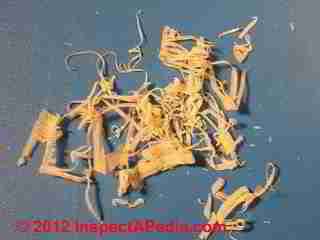 Samples were examined using stereoscopic and polarizing light microscopy. Samples were also exposed to 4% NaOH (sodium hydroxide) and 95% ethyl alcohol (ethanol).
Samples were examined using stereoscopic and polarizing light microscopy. Samples were also exposed to 4% NaOH (sodium hydroxide) and 95% ethyl alcohol (ethanol).
Paint Sample Photo #1 - untreated surface finish shavings
Each paint test sample consists of pale yellow shavings and dust. The object of analysis is standard microscopic and microchemical examination in order to determine if the samples are oil based or acrylic.
Finish samples were removed from the surface of the basketball court by scraping with a sharp chisel. Samples were examined using stereoscopic and polarizing light microscopy. Samples were also exposed to 4% NaOH (sodium hydroxide) and 95% ethyl alcohol (ethanol).
Microscopic examination reveals that samples 01-05 consist primarily of thin, pale yellow, ribbon-like shavings (Photo 1 at left)
Paint Sample Photo #2 - surface shavings in NaOH
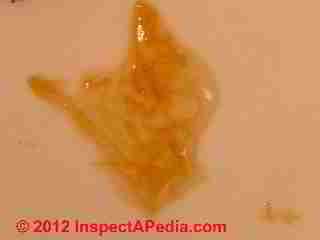 When exposed to 4% NaOH the shavings immediately turn yellow (Photo 2 at left).
When exposed to 4% NaOH the shavings immediately turn yellow (Photo 2 at left).
You will also observe that the sample softens considerably. The sample fragments lie flat, they do not curl.
This is a positive test for oil based paint or varnish, including alkyd. Acrylic finishes do not turn color when exposed to 4% NaOH.
Paint Sample Photo #3 - surface shavings in Ethanol.
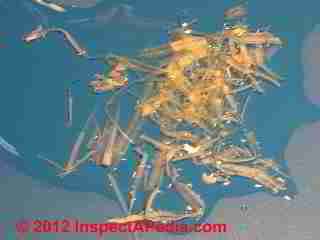
Shavings (01-05) exposed to ethanol did not soften or exhibit other changes such as curling (Photo 3 at left).
If the scrapings were acrylic they would soften and curl when exposed to ethanol.
These observations are evidence that surface samples (01-05) from the tested basketball court surface consist of oil based finish.
These tests were performed in December, 2011 by Dr. Fred Colley and Pyxis Laboratories in Portland OR. Contact information for Dr. Colley and Pyxis are at our References & Technical Reviewers[3] section at the end of this article.
This article is part of our series: Diagnosing and Preventing Paint Failure on Building Exteriors.
...
Reader Comments, Questions & Answers About The Article Above
Below you will find questions and answers previously posted on this page at its page bottom reader comment box.
Reader Q&A - also see RECOMMENDED ARTICLES & FAQs
Question: what technique can I use to distinguish between acrylic and oil-based varnishes?
I have a client who suspects that a [wood floor in a sports facility] was varnished with acrylic rather than oil based varnish. Can you advise me on techniques for confirming the identity of varnish scrapings. I generally use polarizing light microscopy for small particle id but would like to know your approach. Thank you. [Anon.]
Reply: these microchemical methods provide a quick simple forensic procedure that often is sufficient for paint base type identification
Anon: During some investigative work for the NPS a while back I contacted the chemists at several paint companies for help with defining an alternative method for paint characterization other than the very expensive (try more than $1000./sample) gas chromatography. Worse, not only was that method very costly but when I went to one of the biggest test outfits in North America, they did a horrible and incompetent job.
It was evident that at least some of the most costly and sophisticated paint testing labs, their technicians, and procedures have a rather specific focus (such as auto body paint) that may not include expertise on paint analysis for building failures nor for works of art (my areas of interest).
Please take a look at the microchemistry alternative above at PAINT FAILURE CHEMICAL TESTS. There we distinguish between acrylic/latex and oil/alkyd using this method - I invite you to try it and to let me know how you make out or whether or not you have further questions.
Note that although your question referred to oil based varnish, there is virtually no true oil based paint currently sold (that is traditional linseed oil based paints) - they've all been replaced with alkyds. Therefore I think that's what your client wants to look for. If you know otherwise do let me know.
Incidentally, I considered trying to use PLM along with the Baekke method, our standard color chart, and a full set of refractive index liquids to try identifying paint materials. While that approach is rather good at the forensic identification of a very wide range of particles and fibers, without some help from a paint chemist and some specific information not at hand about the precise optical properties of alkyd paint chips and acrylic paint chips, I'm afraid we'd be wasting our time on that approach when making distinctions of chemical constituents.
Finally, when investigating questions about the possible use of a paint product that was not the one anticipated, in addition to forensic investigation of the paint and the building surfaces, it is often most useful to do some old-fashioned detective leg work: obtain copies of the invoices that document where the coating products were purchased as well as just what was bought. Sometimes too we can find leftover paint or coating and primer cans or containers and we also sometimes find in job site photographs an image of the paint cans and their labels.
...
Continue reading at FAILING PAINT SECTIONAL VIEW or select a topic from the closely-related articles below, or see the complete ARTICLE INDEX.
Or see these
Paint Failure Analysis Lab Articles
- PAINT FAILURE, DIAGNOSIS, CURE, PREVENTION - home
- PAINT FAILURE DICTIONARY - illustrated list of all types of paint failures
- PAINT FAILURE LAB ANALYSIS
Suggested citation for this web page
PAINT FAILURE CHEMICAL TESTS at InspectApedia.com - online encyclopedia of building & environmental inspection, testing, diagnosis, repair, & problem prevention advice.
Or see this
INDEX to RELATED ARTICLES: ARTICLE INDEX to PAINTS & STAINS & FAILURES
Or use the SEARCH BOX found below to Ask a Question or Search InspectApedia
Ask a Question or Search InspectApedia
Try the search box just below, or if you prefer, post a question or comment in the Comments box below and we will respond promptly.
Search the InspectApedia website
Note: appearance of your Comment below may be delayed: if your comment contains an image, photograph, web link, or text that looks to the software as if it might be a web link, your posting will appear after it has been approved by a moderator. Apologies for the delay.
Only one image can be added per comment but you can post as many comments, and therefore images, as you like.
You will not receive a notification when a response to your question has been posted.
Please bookmark this page to make it easy for you to check back for our response.
IF above you see "Comment Form is loading comments..." then COMMENT BOX - countable.ca / bawkbox.com IS NOT WORKING.
In any case you are welcome to send an email directly to us at InspectApedia.com at editor@inspectApedia.com
We'll reply to you directly. Please help us help you by noting, in your email, the URL of the InspectApedia page where you wanted to comment.
Citations & References
In addition to any citations in the article above, a full list is available on request.
- [1] Leila Kotama, Product Manager, Tikkurila Paints Oy, Finland. Dr. Kotama has more than 20 years experience as a paint chemist.
- [2]Runeberg, Ulrik, STAINING AND MICROBIOLOGICAL INFESTATION OF ACRYLIC PAINTINGS ON HARDBOARD [PDF] (2008),Conservator (Dipl. Rest./M.A.), Restaurierungszentrum der Landeshauptstadt Düsseldorf, Germany, Email: Rune-Ulrik@gmx.de Previously Museo de Arte Contemporáneo de Puerto Rico, San Juan Presented, April 2007 conference in Richmond Virginia, sponsored by the AIC (American Institute for Conservation), this paper discusses the staining and microbial infestation of acrylic paintings on hardboard. - private correspondence, ER <->DF 2020/01/05 - 2006/09/12. (Also see PAINT FALURE, DIAGNOSIS, CURE, PREVENTION)
- [3] Fred C. Colley, MPH, PhD, Supervisor, Microbiology Department, Pyxis Laboratories, 12423 NE Whitaker Way Portland, OR 97230. Tel: (503)254-1794, website: pyxislab.com/pyxwww/contact.php, Email: customerservice@pyxislab.com
- [4] Bodycote Materials Testing, Ontario, Canada
- [5] Paint and Surface Coatings, Theory and Practice, R. Lambourne & T.A. Strivens, Ed., Woodhead Publishing Ltd., William Andrew Publishing, 1999 ISBN 1-85573-348 X & 1-884207-73-1 [This is perhaps the leading reference on modern paints and coatings, but is a difficult text to obtain, and is a bit short on field investigation methods - DF]
Provides a comprehensive reference source for all those in the paint industry, paint manufacturers and raw materials suppliers, undergraduate and postgraduate students, and industrial paint users. R. Lambourne was in the Research Department at ICI Paints Division and the Industrial Colloid Advisory Group, Birstol University, UK. - [6] Paint Test Laboratory Listings Welcome: independent forensic and microscopic or chemistry labs offering paint analysis or paint failure services are welcome to be listed here at no fee. Contact Us
- [7] Analysis of Modern Paints, Thomas J.S. Learner, Research in Conservation, 2004 ISBN 0-89236-779-2 [Chemistry of modern paints, overview of analytical methods, pyrolysis-gas chromatography signatures of basic modern paints and their constituents, Fourier transform infrared spectroscopy for paint analysis, direct temperature-resolved mass spectrometry, and analysis in practice - technical reference useful for forensic paint science, focused on art works -DF]
- [8] Art, Biology, and Conservation: Biodeterioration in Works of Art, Robert J. Koestler et als. Eds., Metropolitan Museum of Art, 2003, ISBN 1-58839-107-8
- Seeing Through Paintings, Physical Examination in Art Historical Studies, Andrea Kirsh, Rustin S. Levenson, Materials in Fine Arts, 2000 ISBN 99-051835 [ forensic science, technical reference, focused on art works - DF]
One of the best texts available for forensic investigation of the history, authenticity, and condition of paintings - DF - Building Pathology, Deterioration, Diagnostics, and Intervention, Samuel Y. Harris, P.E., AIA, Esq., ISBN 0-471-33172-4, John Wiley & Sons, 2001 [General building science-DF - ** Particularly useful text **
- [9] Paint Handbook: testing, selection, application, troubleshooting, surface preparation, etc., Guy E. Weismantel, Ed., McGraw Hill Book Company, 1981, ISBN-10: 0070690618, ISBN-13: 978-0070690615, [Excellent but a bit obsolete paint theory and practice, also a bit light on field investigation methods, out of print, available used-DF]
How to select and apply the right paint or coating for any surface. The first major reference to help you choose the correct paint or other finish to do the job best on a particular surface exposed to a particular environment. Experts in the field give full advice on testing surface preparation, application, corrosion prevention, and troubleshooting. The handbook covers wood, metal, composites, and masonry, as well as marine applications and roof coatings. A ``must'' working tool for contractors, architects, engineers, specification writers, and paint dealers. - [10] Paint and Surface Coatings, Theory and Practice, R. Lambourne & T.A. Strivens, Ed., Woodhead Publishing Ltd., William Andrew Publishing, 1999 ISBN 1-85573-348 X & 1-884207-73-1 [This is perhaps the leading reference on modern paints and coatings, but is a difficult text to obtain, and is a bit short on field investigation methods - DF]
Provides a comprehensive reference source for all those in the paint industry, paint manufacturers and raw materials suppliers, undergraduate and postgraduate students, and industrial paint users. R. Lambourne was in the Research Department at ICI Paints Division and the Industrial Colloid Advisory Group, Birstol University, UK. - [11] Seeing Through Paintings, Physical Examination in Art Historical Studies, Andrea Kirsh, Rustin S. Levenson, Materials in Fine Arts, 2000 ISBN 99-051835 [ forensic science, technical reference, focused on art works - DF]
- [12] Sealants, Durability of Building Sealants (RILEM Proceedings), J.C. Beech, A.T. Wolf, Spon Press; illustrated edition (1995), ISBN-10: 0419210709, ISBN-13: 978-0419210702
This book presents the papers given at the RILEM Seminar held at the Building Research Establishment, Garston, UK in October 1994. The book provides an opportunity for researchers to review up-to-date progress towards the achievement of the objectives of the standardisation of laboratory techniques of sealants in the variety of service conditions to which they are exposed. - [13] Soiling and Cleaning of Building Facades (RILEM Report), L.G.W. Verhoef (Editor), Routledge; 1 edition (November 3, 1988), ISBN-10: 0412306700, USBN-13: 978-0412306709
The report of a comprehensive investigation by RILEM which examines all aspects of the cleaning of facades, subject to soiling by both biological and non-biological agencies. The contributors are international authorities working in this field giving essential advice to all those who need to know how to approach the problems connected with the soiling and cleaning of building facades. - [14] Staining, Prevention of Premature Staining in New buildings, Phil Parnham, Taylor & Francis; 1996, ISBN-10: 0419171304, ISBN-13: 978-0419171300
The appearance of ugly staining early in a buildings life, ruins an otherwise pleasing appearance, tarnishes the image of the owners and gives rise to costly refurbishment works. In this book Phil Parnham raises a number of questions that should be considered whenever a new building is being designed or built. These are: * why has staining become so prominent; * what causes premature staining; which parts of new buildings are likely to be affected; * how can it be avoided? By using a number of highly illustrated case studies, the author answers these questions and ends by suggesting measures that should be taken by all design and construction professionals to prevent premature staining. - Our recommended books about building & mechanical systems design, inspection, problem diagnosis, and repair, and about indoor environment and IAQ testing, diagnosis, and cleanup are at the InspectAPedia Bookstore. Also see our Book Reviews - InspectAPedia.
- Building Pathology, Deterioration, Diagnostics, and Intervention, Samuel Y. Harris, P.E., AIA, Esq., ISBN 0-471-33172-4, John Wiley & Sons, 2001 [General building science-DF - ** Particularly useful text **
- Dampness in buildings, Diagnosis, Treatment, Instruments, T.A. Oxley & E.G. Gobert, ISBN 0-408-01463-6, Butterworths, 1983-1987 [General building science-DF]
- Certainteed Weatherboard fiber cement siding and trim products - see certainteed.com/ or see certainteed.com/resources/sidingandtrimspecsheet.pdf
- "Moisture Control in buildings: Putting Building Science in Green Building," Alex Wilson, Environmental Building News, Vol. 12. No. 5. [Good tutorial, "Moisture 101" outlining the physics of moisture movement in buildings and a good but incomplete list of general suggestions for moisture control - inadequate attention given to exterior conditions such as roof and surface drainage defects which are among the most-common sources of building moisture and water entry.--DJF]
- "Weather-Resistive Barriers [copy on file as /interiors/Weather_Resistant_Barriers_DOE.pdf ] - ", how to select and install housewrap and other types of weather resistive barriers, U.S. DOE
- In addition to citations & references found in this article, see the research citations given at the end of the related articles found at our suggested
CONTINUE READING or RECOMMENDED ARTICLES.
- Carson, Dunlop & Associates Ltd., 120 Carlton Street Suite 407, Toronto ON M5A 4K2. Tel: (416) 964-9415 1-800-268-7070 Email: info@carsondunlop.com. Alan Carson is a past president of ASHI, the American Society of Home Inspectors.
Thanks to Alan Carson and Bob Dunlop, for permission for InspectAPedia to use text excerpts from The HOME REFERENCE BOOK - the Encyclopedia of Homes and to use illustrations from The ILLUSTRATED HOME .
Carson Dunlop Associates provides extensive home inspection education and report writing material. In gratitude we provide links to tsome Carson Dunlop Associates products and services.


